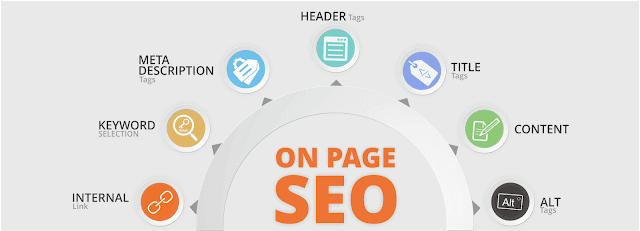In the vast and ever-expanding digital landscape, achieving visibility for your website amidst the sea of online content can feel like navigating through uncharted territory. However, with the right strategies and tactics in place, you can elevate your website’s presence and attract more organic traffic. One such indispensable strategy is On-Page SEO, which involves optimizing various elements directly on your website to improve search engine rankings and enhance user experience. In this comprehensive guide, we’ll delve into a range of On-Page SEO techniques that will help propel your website to the top of search engine results pages (SERPs) and captivate your target audience.

- Harness the Power of Keywords: Keywords are the cornerstone of any successful SEO strategy. Begin by conducting thorough keyword research to identify relevant terms and phrases that align with your business and target audience. Utilize tools like Google Keyword Planner, SEMrush, or Ahrefs to uncover valuable insights into search volume, competition, and keyword variations. Once you’ve compiled a list of target keywords, strategically integrate them into your website’s content, including titles, headings, meta descriptions, and body text. However, ensure that keyword usage feels natural and organic, avoiding any instances of keyword stuffing that could detract from the user experience.
- Craft Compelling and Engaging Content: Content is king in the digital realm, and high-quality content can significantly impact your website’s visibility and engagement. Focus on creating informative, relevant, and engaging content that resonates with your target audience and addresses their needs and interests. Incorporate your target keywords seamlessly into your content while maintaining readability and relevance. Additionally, consider diversifying your content formats to include blog posts, articles, infographics, videos, and interactive elements, catering to different preferences and consumption habits.
- Optimize Meta Tags and Descriptions: Meta tags, including title tags and meta descriptions, serve as essential elements for both search engines and users. Craft compelling and concise title tags that accurately reflect the content of each page while incorporating relevant keywords. Similarly, write compelling meta descriptions that provide a concise summary of the page’s content and entice users to click through from search engine results pages (SERPs). Optimizing meta tags and descriptions not only improves your website’s visibility but also enhances click-through rates (CTR) and user engagement.
- Enhance Page Loading Speed: Page loading speed is a critical factor that significantly impacts user experience and search engine rankings. A slow-loading website can frustrate visitors and lead to higher bounce rates, ultimately harming your website’s visibility and performance. Take proactive steps to optimize your website’s loading speed by optimizing image sizes, leveraging browser caching, minimizing HTTP requests, and reducing unnecessary scripts or plugins. Additionally, consider implementing a content delivery network (CDN) to deliver content more efficiently to users across different geographical locations.
- Adopt a Mobile-Friendly Design: In an increasingly mobile-centric world, ensuring that your website is mobile-friendly is paramount for success. With Google’s mobile-first indexing, the mobile version of your website takes precedence for indexing and ranking purposes. Adopt a responsive web design approach to ensure that your website adapts seamlessly to various screen sizes and devices, providing an optimal viewing experience for mobile users. Test your website’s mobile-friendliness using Google’s Mobile-Friendly Test tool and address any issues that may arise promptly.
- Streamline URL Structure: A clear and concise URL structure not only enhances user experience but also facilitates search engine crawling and indexing. Craft descriptive, keyword-rich URLs that accurately reflect the content and hierarchy of each page on your website. Avoid lengthy, convoluted URLs with unnecessary parameters or symbols, as they can confuse both users and search engine crawlers. Organize your URL structure logically, ensuring that it is intuitive and easy to navigate for both humans and search engines.
- Leverage Internal Linking: Internal linking plays a crucial role in distributing link equity throughout your website and improving crawlability and indexation. Identify relevant anchor text and strategically link to other pages within your website that are thematically related. This not only helps users discover related content but also provides search engines with additional context and signals about the relevance and importance of your pages. However, avoid excessive internal linking and ensure that links are natural and contextually relevant to the content.

Conclusion ;
On-Page SEO techniques are indispensable for enhancing your website’s visibility, attracting organic traffic, and improving user experience. By harnessing the power of keywords, crafting compelling content, optimizing meta tags, enhancing page loading speed, adopting a mobile-friendly design, streamlining URL structure, and leveraging internal linking, you can elevate your website’s presence and achieve sustainable growth in the competitive online landscape.
As businesses navigate the complexities of digital marketing, partnering with experts like Digfinity, a premier digital marketing agency specializing in SEO, can provide invaluable support. With Digfinity’s expertise and tailored strategies, businesses can unlock their full potential, enhance their online visibility, and achieve tangible results in their SEO endeavors. Embrace the power of On-Page SEO and embark on a journey towards greater visibility and success in the digital world.



